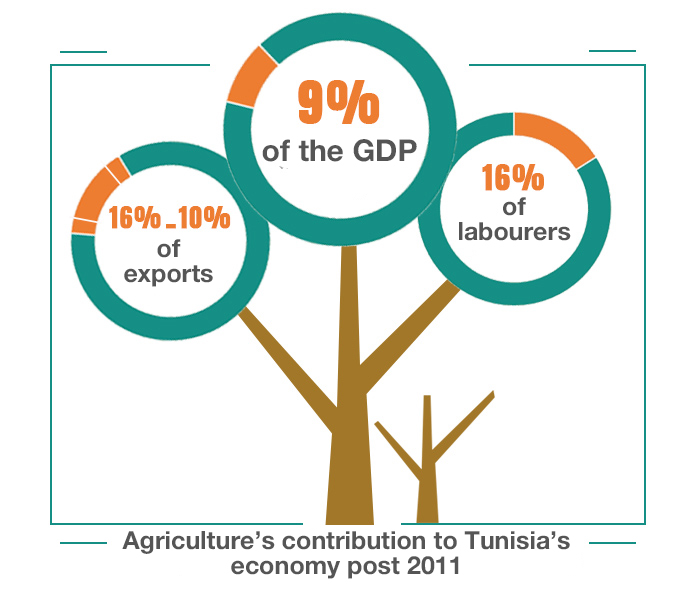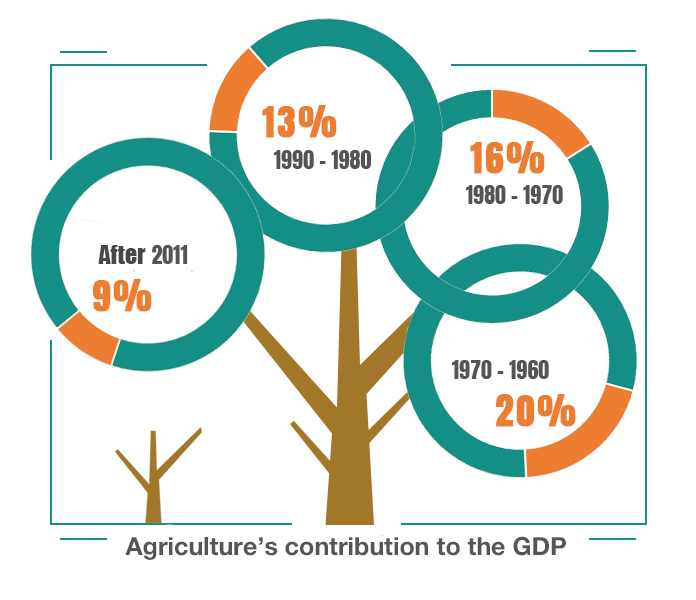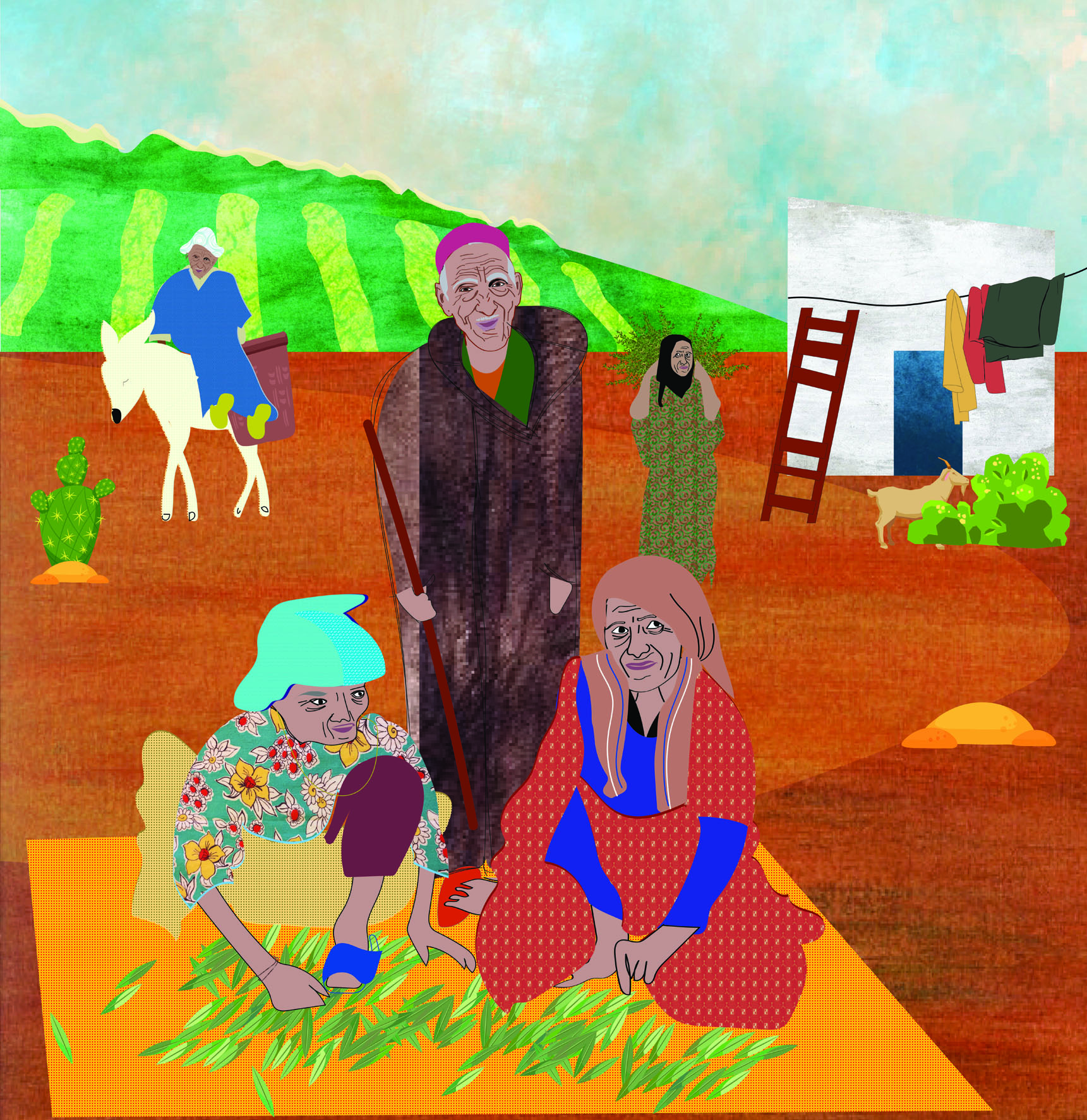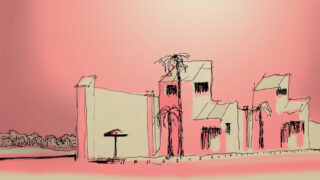
This publication has benefited from the support of the Rosa Luxemburg Foundation. This text may be reproduced in part or in full, provided the source is acknowledged.
“The land of whales (fish), yield (fruits), and olives," was how Farid al-Atrash described Tunisia in his song, Bosat al-Reeh. Many Tunisian and Arab poets and singers extolled the "green" Tunisia. The northwest of the country was once called the "Granary of Rome" due to the abundance of wheat and barley production in that region which was part of the strategic food reserve of the Roman Empire. Tunisia is also the hometown of one of the oldest and most important agricultural scientists, Mago of Carthage, who wrote a 28-volume agricultural encyclopedia. Agriculture had been the backbone of the country's economy throughout the ages up to the seventies of the last century, when it began to decline because of political-economic choices and socio-demographic changes. This decline turned into a real danger, especially with the synergy of other factors, some of which were natural, and others were the direct result of human policies and practices.
In a small country with limited wealth such as Tunisia, agriculture is inextricably linked with two vital issues: Food security and national sovereignty. This implies that a further decline in this sector could lead to starvation or full dependency on foreign countries.
The consequences of the state's economic choices
In the years following independence (1956), Tunisia faced a difficult economic situation that required it start from scratch. Back then, agriculture was the first sector in terms of investment and revenues... It was a simple family-agriculture model that primarily served the local markets. Starting from the sixties, the state tried to boost the economy by developing agriculture and creating a base of national heavy industry. To provide the required resources, it followed policies of mutualisms (semi-socialist cooperatives), but with considerable openness to the western capitalist camp (namely USA and France), while pursuing political rapprochement with this camp to secure its financial and technical support.
During that era, agriculture was at the core of the state’s development plans. Nevertheless, after the failure of the mutuals’ policy (1964-1969), the regime decided to alter its economic approach and appointed the liberal Hedi Nouira as prime minister for a full decade (1970-1980) in which the Tunisian economy and society witnessed drastic changes that most involved the agricultural sector.
The state pursued a new alternative in the framework of "diversifying the economy", gradually abandoning large industrial projects in favor of light factory industries, and welcoming foreign investment by offering very attractive incentives. It also moved towards making "cheap" tourism a strategic sector. As for agriculture, it encouraged farmers to produce agricultural products that could be exported to European markets to bring in hard currency, especially olive oil, citrus fruits, dates and others. It also began to abandon the concept of food security in favor of fewer costs. For example, it started considering importing cereals (mainly soft wheat), sugar, and several other agricultural products that cost less than their production in Tunisia.
The new policies created a new dynamic in investments and revenues, but it was not without a social toll. The wealth became more and more concentrated in the hands of few, and the cost of living began to rise sharply. Uprisings ensued, from “Black Thursday” in January 1978 to the "Bread Uprising" in January 1984. Until the mid-eighties, the state continued to relatively intervene in supporting and directing the agricultural sector but in a limited manner that does not measure up to the vital importance of this sector.
Things further escalated during the era of President Bin Ali, who was zealously involved in implementing the "structural reforms" demanded by the International Monetary Fund (IMF), as by the terms of the World Trade Organization and the partnership requirements of the European Union.
In addition to the effects of neoliberal policies, corruption hit the agricultural sector hard, as fertile lands were granted to those close to the regime, and the monopolists and Mafiosi were provided free reigns to control the distribution channels of both agricultural exported and imported products.
After the January 2011 Revolution, the new rulers continued to implement these policies, and the role of economic and health control agencies in agricultural products declined. In addition, the governments’ instability created an enormous ambiguity regarding future strategies. Currently, agriculture provides 9% of the gross domestic product (GDP), does not employ more than 16% of the workers, and its contribution to export ranges between 10 to 15 %, a significant decline from the figures of the eighties (16 % of GDP) and the nineties (about 13 % of GDP) of the last century, let alone the sixties (between 20 and 25 % of GDP). The central bank's financial policy, too, negatively affected agriculture, especially the small producers whose products were meant for the domestic market rather than for export. The continued floating of the local currency and its collapse in the exchange market harmed the prices of required supplies, most of which were imported, and finally, the constant upping of the interest rates led to a rise in the cost of agricultural loans.


But what is more dangerous than all these developments is what the government is planning for the next period, specifically "The Deep and Comprehensive Free Trade Agreement" with the European Union" (DCFTA / ALECA) that stipulates for freeing agricultural trades that were excluded in previous agreements. Negotiations began in 2016, without opening a national debate that might have allowed the directly involved professionals, trade unions, or people interested in public affairs in general to thoroughly discuss the matters in a way that can influence the decision. Several professional, political, and citizen bodies rejected this agreement and considered it an imminent threat to agriculture and national sovereignty. This "free trade" would make the domestic market vulnerable to the risk of being invaded by European products of highly competitive power that also demanded that the Tunisian producers would adhere to European standards.
This was imposed as Parliament approved the "Food and Feed Safety Law” in February 2019. Despite its attractive title, the law practically burdened most Tunisian farmers with unaffordable requirements, including additional expenses and efforts so that their products matched "international standards".
The impact of social-demographic changes
After independence, the Tunisian state considered education a top priority, investing accordingly a large part of its material and human resources in it, and achieving tangible results such as the significant decline in illiteracy rates, which decreased from 85% in the late 1950s to 19% at the beginning of the century. Very high school attendance rates, estimated currently at 99%, were achieved, after they used to be at around 25% at the time of independence. Due to the great need for employees and staff, the government employed all those with educational degrees and provided them decent wages and adequate privileges. This encouragement of schooling and turning education into a "social elevator" – at least until the mid-nineties of the last century – made Tunisian families consider the education of their children an investment that enables them to advance socially, gradually creating a kind of aversion – and even disdain – to manual and hard occupations and handcrafts, most prominently agriculture.
Around two-thirds of Tunisians are stacked in the largest coastal cities; that creates a double loss: The gnawing of the green areas surrounding these cities, and abandoning agricultural inlands.
From the seventies, the state’s development choices also contributed to alienating the youth and the whole society in general from agricultural work. The state supported the service and light industrial sectors and concentrated on the economic sector in major coastal cities neglecting and marginalizing rural and low urbanized areas. These options made hundreds of thousands of Tunisians gradually abandon their villages and countryside heading to the cities. Naturally, this led to a significant decrease in the number of available agricultural workers, especially among the youth, and consequently the abandonment of vast lands without anyone to take care of them. Mass migration also dismantled the extended tribal and family structures that exploited and managed the collectively owned lands. Nearly two-thirds of Tunisians are stacked in the largest coastal cities, leading to a double loss: The gnawing of the green areas surrounding these cities and the abandonment of the agricultural inlands. In addition, the state's encouragement of the youth to work in Europe since the end of the 1960s created an immigration culture that remains strong today as the number of Tunisian immigrants has exceeded one and a half million out of the 11 million total population of Tunisia.
Consequently, the area of neglected agricultural lands has increased and the agriculture sector has aged. Today, the percentage of workers over 60 years old in agriculture surpasses 45%, whereas the percentage of the youth (less than 35) does not exceed 10% at most. In addition, there are many obstacles facing the youth who are willing to work in this sector, such as the inability to buy or rent lands, and the weakness of the funding mechanisms, both public and private, not to mention the poor practical and theoretical structures that lack compatibility with the country's needs and reality.
Natural and climate risks
The major issues which can soon turn into serious threats to agriculture in Tunisia are the lack of water resources, the phenomenon of expanding desertification, in addition to the effects of environmental pollution.
Water resources are vital for agriculture, and in a country like Tunisia, the arid and semi-arid climates in most regions of the country further complicate matters. One can better assess the criticality of the situation knowing that agriculture consumes around 80% of the water resources (estimated at around 5 billion cubic meters, half of which is low salinity surface water, while the other half is highly saline groundwater). In an effort to gather as much water as possible from precipitation, the Tunisian government has constructed scores of large dams and hundreds of artificial lakes and mountain dams. However, they do not adequately cover the different regions of the country; there are problems concerning maintenance, the cleaning of dams, and the water transportation network, leading to the loss of significant amounts of water. The farmers are partially to blame as well as the common citizens, for in Tunisia, the random drilling of deep wells is a common phenomenon, spreading in a way that is severely damaging to the water table. Furthermore, the eating habits of the Tunisian citizen are characterized by a high demand for irrigated vegetables that consume high quantities of irrigation water. Tunisians consume a lot of tomatoes, peppers, onions, and potatoes (2.5 million tons or 72.5% of the total consumed vegetables) and various kinds of melon (half a million tons, 15% of the total consumed vegetables).
Agricultural lands in Tunisia are estimated at around 10 million hectares (1 hectare is equal to 10 thousand square meters) that are divided into three types of ownership: private property, tribal collective property of about 3 million hectares, and state property of half a million hectares.
Other dangerous phenomena threatening not only agricultural lands but also residential centers are desertification and soil erosion. Of course, some of the reasons are due to climate changes, such as the rise of temperature, shortage of rain, increased salt percentages above and under the ground, as well as the winds and floods. But there are also reasons attributed to the prevailing agricultural policies and practices.
According to Dr Al-Fadel Harzali, a university professor specialized in geography, some of the factors accelerating desertification and soil erosion are the expansion of agricultural lands at the expense of forests, pastures, and steppes, the demographic growth that turned green lands into residential regions, the random irrigation and grazing practices in some regions, and the use of huge modern plowing machines. In this respect, there are estimates by the Ministry of Environment stating that more than two-thirds of the area of the country risk desertification if things continue in the same way.
Environmental pollution, whose consequences started to become clearly evident in the marine-fishing sector, is also turning into a threat to agriculture. This danger does not threaten solely the air; it also threatens the soil and the water table. For instance, agricultural production has greatly decreased in both quality and quantity in the provinces with a high concentration of mines (such as Gafsa), chemical industries (such as Gabes and Sfax), and heavy industries like cement and iron (such as Bizerte). The environmental issue in Tunisia is still a marginal one, but maybe everyone will be awakened when access to clean food and water becomes difficult and costly.
Issues related to ownership and exploitation of land
The area of agricultural lands in Tunisia is estimated at 10 million hectares (a hectare equals 10,000 square meters) divided into three types of ownership: private property, state owned lands (known as Amiri), which is half a million hectares, and tribal collective property lands (1) which is about 3 million hectares. Private lands do not pose any major problems in terms of ownership and management, for their owners are known and may use their land as they please.
On the other hand, agricultural state lands, which are considered among the most fertile lands in Tunisia, are owned by all Tunisians (at least legally and theoretically) and managed by the National Office of State Lands through 3 mechanisms: allocation in the sense of granting them to public institutions, leasing them to companies and individuals, and selling. After independence, the state was the primary exploiter of these lands either directly or by granting them to the farmers' cooperatives. Then, starting from the seventies of the last century and with the Tunisian regime opting for the liberal system, the selling of the lands and the dissolution of the cooperatives to be replaced by investment companies began. When Bin Ali assumed power, the mismanagement of the agricultural state lands worsened. Although the state stopped selling, it started leasing, whether for financial returns or not, the largest and the most fertile of lands for those closest to the regime. After 2011, numerous state villages and lands were seized by small and unemployed farmers, but the state later retrieved most of them. The only experience that survived was that of the self-managed solidarity economy in the “Jemna” oasis in the southernmost of the country. Many parties are demanding that the state distribute lands to the young and poor farmers to secure work for tens of thousands, develop agricultural production, and establish food security. However, the state is stalling and maneuvering, granting priority to private investors, technicians and engineering graduates from agriculture schools, i.e. those who have the money and/or knowledge.
The biggest issue remains to be the collectively owned lands, where the original owner of the land is a group or tribe, and sometimes several tribes claim and dispute the ownership. Due to this ambiguity, the lands cannot be sold or leased, nor can a bank loan be obtained for their reclamation. Such a complex situation leaves hundreds of thousands of hectares of unproductive agricultural lands, with their owners watching with sorrow as they suffer from unemployment or work with low wages on others’ lands or in the cities. The collectively owned lands constituted a chronic headache for the state until it decided to solve the problem by enacting a law in August 2016 regulating the primary system of the collective lands and their management. Nevertheless, the law did not address these issues in depth nor did it provide clear solutions in several complex cases.
Agriculture in Tunisia is primarily a family business. Around 75% of the exploited agricultural lands has an area less than 10 hectares (2). Thus, the small farmers are the backbone of the agricultural sector, and the problem is that they are the poorest and the least capable of obtaining funds. Since the end of the eighties, the role of agricultural companies and investors started to gain more and more prominence until the amount of investment in the year 2018 reached around 1500 billion Dinars (3) (500 million dollars). This on-going buildup of the influence of the big capital might develop production and bring hard currency, but this is not without damages on the food security level and natural resources, and even the cost of living. The investor will target the more profitable plants and the ones that are export-oriented that will require large quantities of water and/or do not satisfy the basic requirements of the local market. He will try to regain his investment capital and to profit as soon as possible, by turning to extensive use of fertilizers, medicines, and modern agricultural machinery... All this had its negative impact on the environment, the quality of the land, and land fertility in general.
Agriculture in Tunisia is primarily a family business. Around 75% of the exploited agricultural lands is smaller than 10 hectares. Thus, the small farmers constitute the backbone of the agricultural sector, yet the problem is that they are the poorest and least capable of obtaining funds.
Foreign investment in agriculture in Tunisia remains limited; it ranges from 15 to 25 million dinars, making less than 2% of total foreign investments (which is in the range of 2000 million dinars annually). Non-Tunisians are not permitted to own agricultural lands, but they can contribute to the capital of Tunisian companies that rent state-owned (Amiri) agricultural lands. In 2016, the government and its expert consultants tried to circumvent this ban by recommending a paragraph in the New Investment Code that would allow foreigners to own shares in Tunisian companies that own and exploit agricultural lands. However, the protests of several deputies and the news breaking out to public opinion forced the government to (perhaps temporarily?) back down.
Exhausting and impoverishing the land
The Tunisian farmer, like all the farmers of the world, used to keep the seeds to plant them the next season, passing them on from one generation to another. However, from the 1060s onward, foreign seeds started to find their way into the agricultural lands by applying almost the same tactics used by drug dealers. As explained by Abdel Hamid al-Zamouri, president of the Association of Sustainable Development: "Tunisia, like all other countries that are classified as poor, was receiving food aids from the World Food Program (…) These aids were distributed in the rural areas by mostly illiterate mayors and Sheikhs. The seeds which came from the "kind donors" were distributed and granted "with total innocence" for free to the farmers, accompanied with an explanation about their quality and high yields. When it became clear for the “philanthropist donors” that the farmers have relinquished their indigenous seeds and stopped stocking them, they flooded the market with imported seeds, now no longer donated but sold for a fixed price…”.
With the collusion of the state by rationing the import of seeds in the last decade of the past century, this “occupation” paved the way for the giant American companies like Monsanto and the European ones like Vilmorin and Syngenta to dominate the market. Currently, Tunisia imports around 90% of its vegetable seeds after it used to be completely dependent on local seeds. And except for hard wheat and to a lesser extent, soft wheat (thanks to the research and efforts of the National Institute of Agriculture Research), most of the crops and plants in Tunisia are almost exclusively reliant on imported seeds.
But why all this apprehension about imported seeds, although they are claimed to be highly productive? Simply put: their harm outweighs their benefits. These seeds are too expensive; their costs are on a continuous rise, and their domination of the market means the deprivation of the small farmers from sufficient seeds to cultivate their lands and improve their conditions on the one hand, and the increase in the costs of farmers’ products, which burdens the purchasing power of most citizens, on the other hand. This is the less serious part of this issue, for a significant percentage of these seeds are genetically modified hybrid and sterile, i.e. cannot be used more than once nor can they be stored. Moreover, many countries' experiences have demonstrated that the seeds of these giant companies gradually impoverish the soil forcing the farmers to increase their use of fertilizers. In Tunisia for example, the average use of fertilizers has risen from 5 kilograms per one hectare at the beginning of the 1960s to 25 kilograms in the mid-1990s. Many farmers and agriculture experts are warning of new diseases affecting Tunisian plants that demand an intensive use of medicines.
The land was deprived of the seeds it had adapted to over thousands of years, only to be impoverished, depleted and even sterilized with seeds designed in laboratories thousands of miles away. This is not to mention the decline in quality, taste, and nutritional value. In this respect, the most dangerous of all consequences is the health hazards that might be inflicted on humans due to the intense consumption of genetically modified components. Nevertheless, perhaps the bright side of this appears to be the efforts made by “The National Gene Bank” to preserve what has remained of Tunisian indigenous seeds and attempt to recover some of what had been looted and distributed in gene banks across the world. These efforts were successful in retrieving around 6000 types of seeds according to the statements of the Bank’s Director in February 2019.
In conclusion
Tunisian agriculture is faced by major questions and stakes today: How can this sector be made "attractive and appealing” for the youth? How could the production be increased without depleting the lands, while preserving the limited natural resources? What is more important; hard currency or food security, investments or national sovereignty? Is it not time for total "agricultural reform" that could lift hundreds of thousands of Tunisians from poverty and upsurge the size of agricultural production in Tunisia?
The agriculture crisis is not like the crises of the other economic sectors where issues are solved with urgent decisions or pumping some money. Here, we are talking about a matter of national security that should never be controlled by the whims of consecutive governments or the speculations of the investors. Saving agriculture and land is indeed a national duty that concerns everyone, including political parties, professional organizations, civil society, and media among others, but it is a certainty that the greatest responsibility lies on the state, whether by providing solutions, or by establishing scientific, technical and financial structures that are capable of developing this sector in a sustainable manner.
The content of this publication is the sole responsibility of Assafir Al-Arabi and Rosa Luxemburg Foundation cannot accept any liability for it.
Translated from Arabic by Ghassan Rimlawi
Published in Assafir Al-Arabi on 21/03/2019
1 - https://www.asjp.cerist.dz/en/article/6463agricultural
2 - Statistics of the Agency of Promotion of Agricultural investment.
3 - http://www.apia.com.tn/ar





